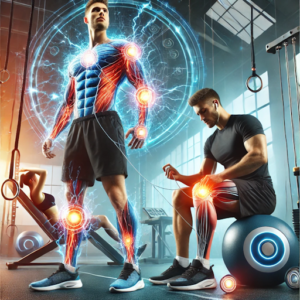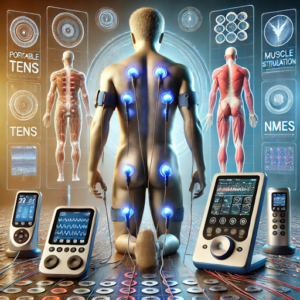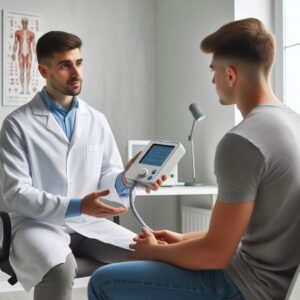Unlocking Muscle Recovery Through Electrotherapy
Electrotherapy for muscle revitalisation is an innovative therapeutic method that uses electrical energy to stimulate the body’s tissues. It plays a key role in physical rehabilitation and wellness today. Far from being a modern-day trend, this method has deep historical roots, with evidence of electrical phenomena being used for healing in ancient civilisations. Today, electrotherapy encompasses a variety of techniques, including transcutaneous electrical nerve stimulation (TENS), neuromuscular electrical stimulation (NMES), and interferential current therapy, each designed to address specific health concerns.
A growing understanding of human physiology and pain management has driven the evolution of electrotherapy. This progress has cemented electrotherapy as a pivotal component of modern therapeutic practices. Its resurgence in popularity can be attributed to its non-invasive nature and the mounting evidence supporting its effectiveness. As more individuals seek non-medicinal options for managing pain, electrotherapy stands out as an appealing solution, offering relief for muscle pain, enhancing recovery from injuries, and improving overall physical well-being.
The appeal lies in its capacity to alleviate discomfort and its potential to enhance muscle function and promote healing. As we explore the mechanisms behind electrotherapy, it becomes clear that this versatile approach holds numerous benefits for individuals looking to optimise their physical health and wellness.
Key Insights into Electrotherapy
- Electrotherapy is a treatment that uses electrical energy to activate muscle tissue, supporting healing and recovery.
- It sends electrical impulses to targeted body areas, helping reduce pain, boost muscle strength, and improve blood circulation.
- Electrotherapy offers advantages such as pain relief, muscle relaxation, increased range of motion, and faster tissue healing.
- A range of electrotherapy devices, such as TENS units, EMS devices, and ultrasound machines, are available, each offering unique benefits depending on its application.
- When using electrotherapy devices, it’s essential to follow the manufacturer’s instructions and consult a healthcare professional if you have any concerns or underlying health conditions.
 Understanding Electrotherapy: How It Heals and Restores
Understanding Electrotherapy: How It Heals and Restores
Electrotherapy applies electrical currents to the body via electrodes placed on the skin, triggering various physiological responses. These electrical impulses interact with nerve fibres and muscle tissues, resulting in therapeutic effects. For instance, TENS therapy delivers low-voltage signals that block pain signals from reaching the brain, relieving chronic pain conditions.
This process is similar to the body’s natural pain-relief mechanism, encouraging the release of endorphins—natural painkillers that reduce pain perception. Neuromuscular electrical stimulation (NMES) takes this further by directly targeting muscle fibres. NMES stimulates motor neurons, causing muscles to contract, which aids in strengthening muscles and is an integral part of rehabilitation following injury or surgery.
This combination of pain relief and muscle activation showcases the diverse potential of electrotherapy as a treatment. As research continues to uncover the intricate effects of electrical stimulation on cellular processes and tissue repair, electrotherapy is increasingly seen as a long-term solution for muscle recovery and rejuvenation.
Top Benefits of Electrotherapy for Muscle Healing
Electrotherapy offers many benefits, making it a popular choice for athletes, individuals recovering from injuries, and those looking to improve their physical performance. One key advantage is its ability to accelerate recovery from muscle injuries. Electrotherapy can speed up the healing process of muscle strains and tears by stimulating blood flow and reducing inflammation.
This treatment is particularly beneficial for athletes returning to their sport after injury, as it helps them regain strength and functionality faster than traditional rehabilitation methods alone. Electrotherapy is also effective in building muscle strength and endurance. Regular use of NMES devices can lead to increased muscle mass and improved neuromuscular coordination, both critical for peak physical performance.
In addition to aiding injury recovery, electrotherapy can be an excellent option for individuals who have difficulty engaging in traditional exercise due to pain or mobility issues. By stimulating muscle activity without the need for strenuous physical exertion, electrotherapy helps maintain muscle mass and prevent muscle atrophy, making it an invaluable tool for those with limited mobility.
 Exploring the Different Electrotherapy Devices
Exploring the Different Electrotherapy Devices
Electrotherapy devices vary widely in their design and applications, allowing them to meet diverse therapeutic needs. The TENS unit is one of the most commonly used devices for pain management. These portable devices are often equipped with multiple settings, enabling users to adjust the intensity and frequency of electrical impulses according to their comfort levels.
TENS units are ideal for home use, offering individuals a convenient way to manage chronic pain conditions like arthritis or lower back pain without relying solely on medication. In contrast, NMES devices are specifically designed for muscle stimulation and rehabilitation. These units range from simple, handheld devices to advanced systems used in clinical settings.
Many NMES devices have programmable settings that allow healthcare providers to tailor treatment protocols to each patient’s specific needs. Additionally, hybrid devices that combine the capabilities of TENS and NMES offer a comprehensive solution for pain relief and muscle recovery. As technology evolves, we can expect more sophisticated electrotherapy devices that further enhance user experience and therapeutic outcomes.
Using Electrotherapy for Maximum Muscle Recovery
When incorporating electrotherapy into your muscle recovery routine, a strategic approach is necessary to achieve the best results and minimise discomfort. Consulting a healthcare professional or physiotherapist before starting an electrotherapy regimen is essential. They can guide you in selecting the right device for your needs and help develop a personalised treatment plan.
After selecting a device, familiarising yourself with its functionality is crucial. Most electrotherapy units come with user manuals that provide instructions on placing electrodes correctly and adjusting settings for optimal results. Proper electrode placement ensures that electrical impulses target the intended muscles and nerve fibres effectively.
It’s advisable to start with lower-intensity settings and gradually increase them as you become more comfortable. Sessions typically last 20 to 30 minutes, though the duration can be adjusted based on individual tolerance and treatment goals. Consistency is vital to reaping the benefits of electrotherapy—incorporating it into your routine several times a week can significantly improve muscle strength and recovery.
Monitoring your progress and adjusting your treatment plan as necessary will help you optimise the therapeutic effects of electrotherapy, making it a powerful tool in your muscle recovery journey.
 Essential Safety Precautions for Electrotherapy
Essential Safety Precautions for Electrotherapy
While electrotherapy is generally safe, certain precautions must be taken to ensure its safe and effective use. Individuals with pre-existing medical conditions such as epilepsy or heart disease or those with implanted devices like pacemakers should avoid using electrotherapy without consulting a healthcare professional. The electrical impulses could interfere with these devices or conditions, potentially causing serious complications.
Pregnant women should also seek medical advice before using electrotherapy, as its effects during pregnancy have not been thoroughly studied. Another important consideration is skin sensitivity. Some individuals may experience irritation or allergic reactions at the electrode sites. To minimise the risk of irritation, use hypoallergenic electrodes and ensure the skin is clean and dry before applying them.
Additionally, it’s essential to avoid placing electrodes on areas with broken skin, rashes, or wounds, as this could lead to further irritation or infection. Paying attention to your body during treatment is key—if you experience discomfort or any unusual reactions, you should stop using the device and consult a healthcare provider. By following these guidelines, you can safely enjoy the benefits of electrotherapy.
Making Electrotherapy a Part of Your Muscle Recovery Routine
Integrating electrotherapy into your routine can significantly enhance muscle recovery and overall physical performance. Whether you’re an athlete, recovering from surgery, or dealing with chronic pain, electrotherapy offers an effective, non-invasive option for improving muscle function and speeding up recovery.
Incorporating electrotherapy into a well-rounded recovery plan that includes traditional rehabilitation methods like physiotherapy and massage can provide a comprehensive approach to healing. Electrotherapy can help you reach your fitness and recovery goals more effectively by reducing pain, improving circulation, and promoting muscle activation.
To maximise its benefits, follow best practices, seek guidance from healthcare professionals, and maintain consistency in your electrotherapy sessions. As the science behind electrotherapy advances, this therapy is poised to play an even greater role in muscle recovery and physical wellness. Electrotherapy is not just a temporary fix—it’s a long-term solution for those committed to improving their health and vitality.
Electrotherapy is a promising tool for muscle recovery, but it can also be complemented by other therapies for even better results. One such therapy is cupping, which has gained popularity for improving circulation and relieving muscle tension. To explore how cupping can work alongside electrotherapy, you might enjoy reading “Cupping Therapies: Unveiling the Mysteries.”
Frequently Asked Questions About Electrotherapy
What is electrotherapy for muscles?
Electrotherapy is a technique that uses electrical stimulation to relieve pain, improve muscle strength, and accelerate the healing process.
How does electrotherapy work?
Electrotherapy sends electrical impulses through the skin to the muscles, relieving pain, improving circulation, and inducing muscle contractions.
What are the benefits of electrotherapy for muscles?
Electrotherapy can reduce pain, increase muscle strength and endurance, improve mobility, and speed up recovery from muscle injuries.
Are there any risks associated with muscle electrotherapy?
Electrotherapy is safe when performed correctly by trained professionals. However, following healthcare guidelines is important to minimise any potential risks.
Who can benefit from electrotherapy?
Electrotherapy can help those experiencing muscle pain, weakness, or injury. It’s also useful for rehabilitation after surgery or injury.
What are the possible side effects of electrotherapy?
Electrotherapy is not recommended for pregnant women, individuals with pacemakers or other implanted devices, or those with certain skin conditions. If you have concerns, consult with a healthcare provider before using electrotherapy.
Brought to you by: Electrotherapy Preston
The Article: Muscle Revitalisation with Electrotherapy appeared first on https://mcrtherapies.co.uk
The Article Muscle Revitalisation with Electrotherapy appeared first on https://mcrtherapies.com
The Article Muscle Revitalisation with Electrotherapy Was Found On https://limitsofstrategy.com


Your exploration of electrotherapy and its historical roots captures the essence of how ancient practices can inform modern techniques in muscle recovery. I’ve personally experienced the benefits of TENS therapy after an injury, which has not only alleviated pain but also accelerated my rehabilitation process. In my own journey, it’s fascinating to see how these methods have evolved alongside advancements in our understanding of physiology.
It’s great to hear about your personal experience with TENS therapy. It really highlights how ancient practices have found new life in modern health care. The way these techniques tie into our growing knowledge of the nervous system and pain management is fascinating.
I completely agree. It’s intriguing to see how these ancient practices, like TENS therapy, are being reinterpreted in the context of our modern understanding of the nervous system and pain management. It reminds me of how acupuncture has also been embraced in many clinical settings, blending traditional wisdom with contemporary science.
It’s wonderful to hear about your personal experience with TENS therapy. The way you describe its impact on your recovery really highlights the practical benefits of electrotherapy in action. It’s fascinating to think about how these ancient practices have stood the test of time and adapted to fit our modern understanding of the body’s complex physiology.
I appreciate your insights on TENS therapy and its place in both history and modern medicine. It’s interesting to see how practices that date back to ancient times, like acupuncture and even simpler forms of electrotherapy, have evolved with our expanding knowledge of physiology.
You’ve hit on something really fascinating about the journey of these therapies. It’s intriguing how practices like acupuncture, which have roots going back thousands of years, remind us that human beings have long sought ways to understand and manage pain. The shift from ancient understandings—often tied to philosophies about energy or balance—to the modern science of physiology is more than just a story of progress; it reflects our evolving relationship with our own bodies and the mysteries they hold.
It’s fascinating how our understanding of health and pain management has come full circle. Practices like acupuncture and early electrotherapy have laid a foundation that today allows us to explore more nuanced approaches. TENS therapy reflects that journey—it’s remarkable how a technology rooted in the past is being refined with modern research. It makes you wonder what future discoveries are waiting for us, potentially blending traditional knowledge with new innovations. How do you see these practices evolving in the next few years?
It’s really interesting how TENS therapy manages to bridge ancient wisdom and modern science. I’ve found that understanding the body’s complex physiology enhances our appreciation for these techniques. It reminds me of how acupuncture has also evolved—something that seems so simple, yet it taps into intricate body systems.
Your experience with TENS therapy really highlights the profound connection between ancient wisdom and contemporary science. It’s intriguing how these methods, once considered alternative or experimental, have found their way into mainstream medical practices, bridging cultural traditions and modern technology.
It’s really intriguing to hear about your experience with TENS therapy. It’s amazing how a technique rooted in ancient practices can become a lifeline in modern rehabilitation. I often think about the wisdom embedded in these long-standing methods.
I always found it fascinating that the ancients were zapping themselves long before anyone really knew what they were doing—kind of like that friend you have who insists on fixing their own car by banging it with a wrench (we love them anyway, right?). But seriously, it’s interesting how the perception of electrotherapy has evolved. It’s as if ancient Greeks had an ultra-early “pain management” manual, minus the TikTok videos and influencer endorsements.
You’re spot on with that comparison! It really is intriguing how those ancient practices in electrotherapy resemble a sort of hands-on experimentation, much like our DIY friends tinkering away in the garage. The ancient Greeks were tapping into nature’s forces, using electric fish to relieve pain, long before we had any real scientific framework to back it up.
You make a great point about the ancient Greeks having their own version of pain management techniques. It’s pretty wild to think that even back then, they were experimenting with electrical stimulation from things like electric fish. In a way, it’s a reminder that humans have always been curious and resourceful when it comes to pain relief.
You raise an interesting point about the ingenuity of the ancient Greeks in their exploration of pain management techniques. It’s fascinating to think about how they looked beyond conventional methods to find relief. The use of electric fish isn’t just an anecdote; it represents a broader human tendency to investigate nature for solutions to our problems.
It’s fascinating to think about how ancient civilizations like the Greeks approached pain management. Their use of electric fish for stimulation is such an interesting example of early experimentation, and it raises questions about how much we’ve learned—and perhaps how much we’ve lost—in our understanding of health and wellness over the centuries.
It’s a valid point you raise. The ancients certainly had a different approach to pain management, often blending observation with trial and error. It’s intriguing to think about how they used natural phenomena like electric fish for therapeutic purposes with no structured scientific framework. They were not so much “fixing” themselves as they were experimenting, much like that well-meaning friend.
It’s fascinating to see how electrotherapy is rooted in ancient practices yet continues to evolve with our understanding of physiology. I’ve personally experienced TENS therapy for chronic pain and found it remarkably helpful in managing discomfort without the need for medication. It intrigues me how technology bridges the gap between traditional healing methods and modern science, making therapies accessible to so many.
Electrotherapy presents such a fascinating intersection between historical practices and cutting-edge technology in the field of physical health. Your mention of its roots in ancient civilisations resonates with the ongoing dialogue about how far we have come in understanding the body and healing processes. For instance, in the Roman Empire, there are documented cases of using electric fish to relieve pain, which highlights the long-standing intrigue with the body’s electrical potential long before we had the technology to harness it to the level we do today.
You’ve hit on something really intriguing there. It’s amazing how our ancestors were basically the original biohackers, experimenting with the natural world while we were still trying to figure out how to pick fruit without a manual. Scooting electric fish around to zap their aches and pains? That’s some high-level creativity right there! You can almost picture a Roman citizen making small talk at the market, saying, “Hey, you better watch out – those electric eels are not just for show! They’re the latest craze for your bad back!”
It’s fascinating to consider how electrotherapy blends ancient healing practices with modern technology to support muscle recovery. As someone who has explored various rehabilitation techniques, I’ve experienced first-hand how non-invasive approaches can enhance recovery without the risks associated with more invasive treatments.
It’s interesting that you mention the blend of ancient practices and modern technology in electrotherapy. I’ve always found it compelling how various cultures have historically used electrical stimulation, like with ancient Greeks using torpedo fish for pain relief, and how that has evolved into what we have today.
It really is fascinating how those ancient practices laid the groundwork for modern techniques. The Greeks using torpedo fish for pain relief feels almost like a precursor for our understanding of bioelectrical signals today. It makes me think about how different cultures have interacted with natural elements and then adapted those interactions into something that fits their contemporary understanding of health.
It’s interesting to hear your perspective on electrotherapy and its roots in ancient practices. I’ve always been struck by how many modern techniques can trace their origins back to historical methods of healing. The idea of using electricity to promote healing feels like a natural evolution of practices like acupuncture or massage, where the body is seen as having pathways that can be influenced for better health.
It’s fascinating to see how electrotherapy has evolved from its ancient roots into a cutting-edge tool for recovery! I’ve personally experienced the benefits of TENS therapy after an injury, and the relief it brought was surprising. It’s interesting to consider how these technologies can complement traditional rehab methods, possibly reshaping our understanding of recovery timelines.
Your exploration of electrotherapy is fascinating! I appreciate how you highlighted its historical roots alongside modern applications. It’s intriguing to think about how ancient civilisations intuitively tapped into electrical phenomena for healing—there’s something deeply connective about that legacy.